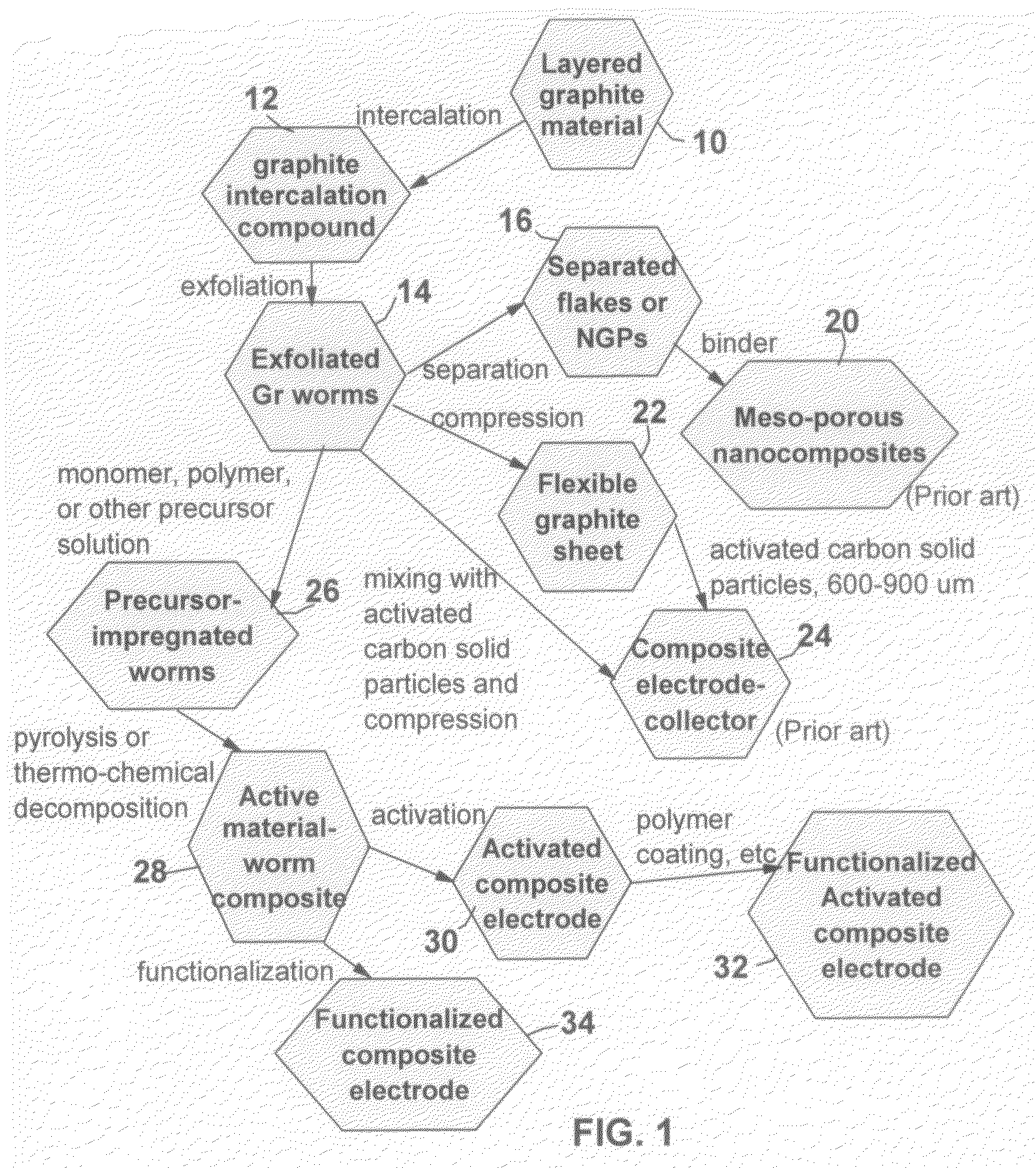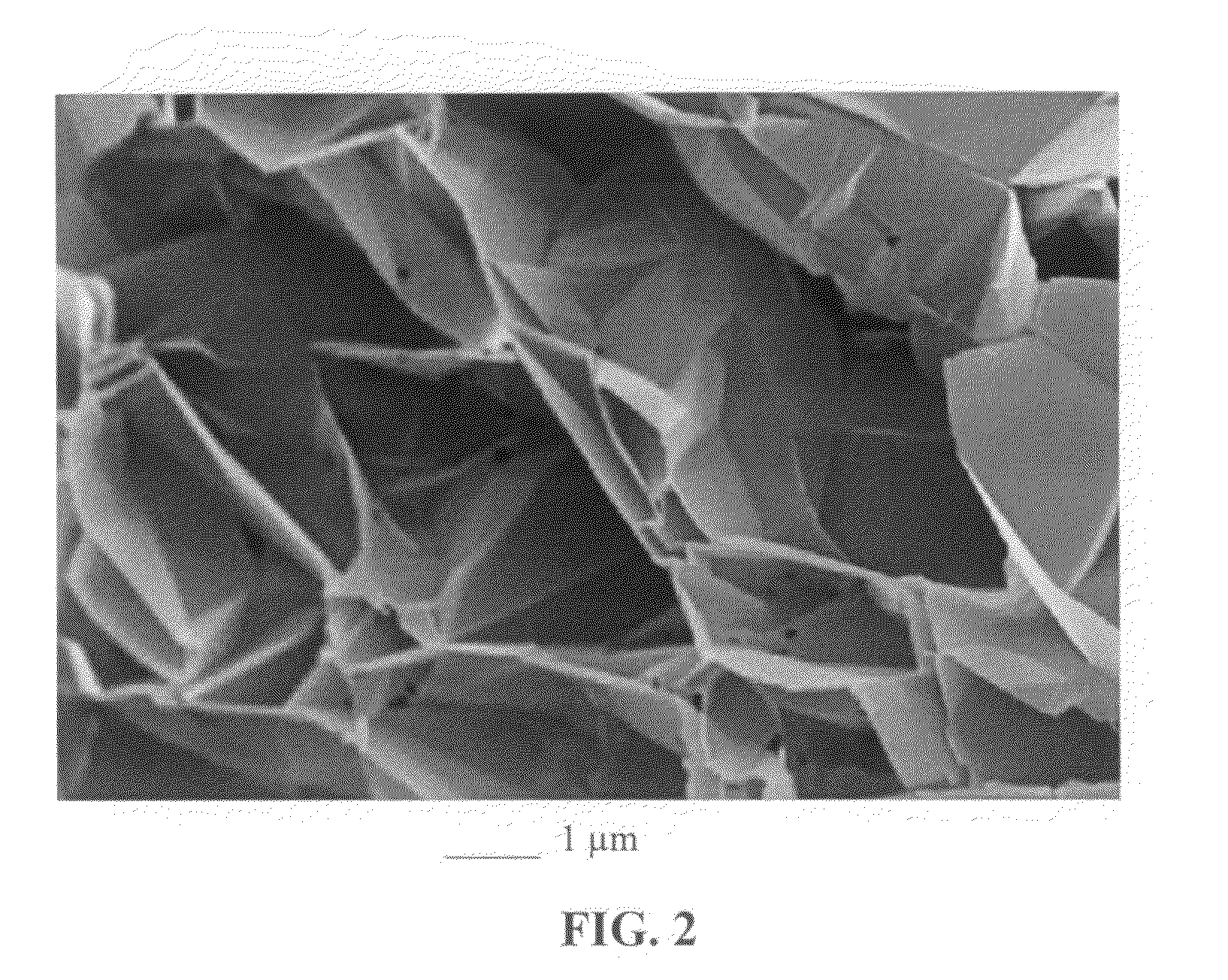Graphite-carbon composite electrode for supercapacitors
a graphite carbon composite and supercapacitor technology, applied in the direction of cellulosic plastic layered products, casings/cabinets/drawers, electric apparatus casings/cabinets/drawers, etc., can solve the problems of double layer formation nano-tubes or nano-fibers are extremely expensive, etc., to reduce internal resistance and conductivity. , the effect of low conductivity
- Summary
- Abstract
- Description
- Claims
- Application Information
AI Technical Summary
Benefits of technology
Problems solved by technology
Method used
Image
Examples
example 1
Hydrogen Peroxide-Assisted, Formic Acid-Intercalated Graphite and Exfoliated Graphite from Highly Oriented Pyrolytic Graphite (HOPG) Flakes
[0084]One hundred grams of HOPG flakes of approximately 20 μm in size, were immersed in a mixture of 50 L of formic acid and 2.5 L of hydrogen peroxide at 45° C. for 24 hours. Following the chemical oxidation intercalation treatment, the resulting intercalated flakes were washed with water and dried. The resulting product is a formic acid-intercalated graphite compound.
[0085]Subsequently, the intercalated compound was transferred to a furnace pre-set at a temperature of 800° C. for 30 seconds. The compound was found to induce extremely rapid and high expansions of graphite crystallites with an expansion ratio of greater than 200. The thickness of exfoliated graphite flakes of the resulting worms (Sample 1-A) ranged from two graphene sheets to approximately 26 graphene sheets (average of 12 sheets or approximately 4.0 nm) based on SEM and TEM obse...
example 2
Sulfuric-Nitric Acid-Intercalated Natural Flake Graphite
[0089]Ten grams of natural flake graphite, provided by Asbury Carbons (405 Old Main St., Asbury, N.J. 08802, USA), were intercalated with a mixture of sulfuric acid, nitric acid, and potassium permanganate at a weight ratio of 4:1:0.05 (graphite-to-intercalate ratio of 1:3) for 48 hours. Upon completion of the intercalation reaction, the mixture was poured into deionized water and filtered. The sample was then washed with 5% HCl solution to remove most of the sulfate ions and residual salt and then repeatedly rinsed with deionized water until the pH of the filtrate was approximately 5. The dried sample was then exfoliated at 1,050° C. for 45 seconds. The resulting worms were examined using SEM and TEM and the thickness of constituent flakes was in the range of 0.34 nm and 1.36 nm (but, mostly single- or double-layer flakes). The specific surface area is approximately 1,520 m2 / g.
[0090]The worms were subjected to the same impregn...
example 3
Repeated Interaction and Exfoliation of Meso-Carbon Micro-Beads (MCMBs)
[0091]MCMB 2528 microbeads were supplied by Alumina Trading, which is the U.S. distributor for the supplier, Osaka Gas Company of Japan. This material has a density of about 2.24 g / cm3; a particle size maximum for at least 95% by weight of the particles of 37 microns; median size of about 22.5 microns and an inter-planar distance of about 0.336 nm. MCMBs were treated with a mixture of sulfuric acid, sodium nitrate, and potassium permanganate according to the method of Hummers [U.S. Pat. No. 2,798,878, Jul. 9, 1957]. Upon completion of the reaction, the mixture was poured into deionized water and filtered. The sample was then washed with 5% HCl solution to remove most of the sulfate ions and residual salt and then repeatedly rinsed with deionized water until the pH of the filtrate was approximately 7. The intent was to remove all sulfuric and nitric acid residue out of graphite interstices. The slurry was spray-dr...
PUM
| Property | Measurement | Unit |
|---|---|---|
| thickness | aaaaa | aaaaa |
| thickness | aaaaa | aaaaa |
| surface area | aaaaa | aaaaa |
Abstract
Description
Claims
Application Information
 Login to View More
Login to View More - R&D
- Intellectual Property
- Life Sciences
- Materials
- Tech Scout
- Unparalleled Data Quality
- Higher Quality Content
- 60% Fewer Hallucinations
Browse by: Latest US Patents, China's latest patents, Technical Efficacy Thesaurus, Application Domain, Technology Topic, Popular Technical Reports.
© 2025 PatSnap. All rights reserved.Legal|Privacy policy|Modern Slavery Act Transparency Statement|Sitemap|About US| Contact US: help@patsnap.com



